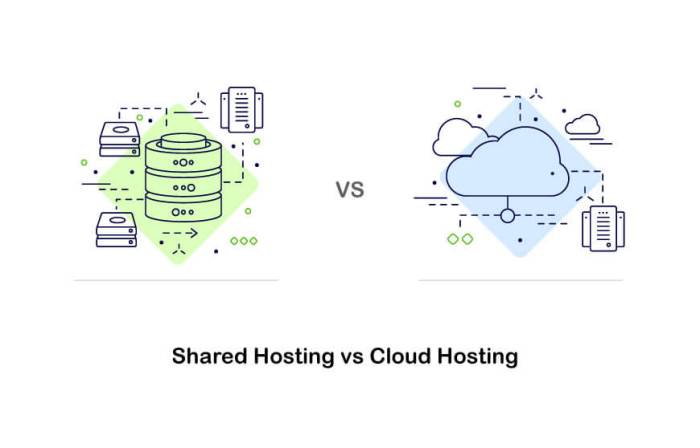How to migrate a website from shared hosting to cloud hosting is a journey that can unlock incredible potential for your online presence. It’s a chance to move away from the limitations of shared servers and embrace the scalability, flexibility, and security of the cloud.
But before diving into the technical details, it’s crucial to understand the fundamental differences between these two hosting environments.
Shared hosting, as the name suggests, involves sharing server resources with other websites. This can lead to performance bottlenecks, especially during peak traffic hours. Cloud hosting, on the other hand, provides dedicated resources and allows for easy scaling based on your website’s needs.
You’ll gain greater control over your environment, enabling you to optimize for speed and security with greater ease.
Understanding the Differences: How To Migrate A Website From Shared Hosting To Cloud Hosting
Before embarking on your website migration journey, it’s crucial to grasp the fundamental distinctions between shared hosting and cloud hosting. This understanding will empower you to make an informed decision that aligns with your website’s specific needs and growth aspirations.
Shared Hosting vs. Cloud Hosting
Shared hosting is a cost-effective option for basic websites with low traffic volumes. In this model, multiple websites share the same server resources, leading to potential performance limitations and security vulnerabilities. Conversely, cloud hosting offers a more scalable and robust solution.
Websites hosted on a cloud platform leverage a network of interconnected servers, ensuring high availability, performance, and security.
Advantages and Disadvantages
- Shared Hosting
- Advantages:
- Cost-effective
- Easy to set up
- Suitable for basic websites with low traffic
- Disadvantages:
- Limited resources and performance
- Vulnerability to security breaches
- Lack of scalability
- Limited control over server settings
- Advantages:
- Cloud Hosting
- Advantages:
- Scalable and flexible
- High performance and reliability
- Enhanced security
- Greater control over server settings
- Disadvantages:
- Can be more expensive than shared hosting
- Requires technical expertise to manage
- Advantages:
Popular Cloud Hosting Providers
- Amazon Web Services (AWS):Offers a wide range of cloud services, including EC2 (Elastic Compute Cloud), S3 (Simple Storage Service), and Route 53 (Domain Name System).
- Microsoft Azure:Provides a comprehensive cloud platform with services such as Virtual Machines, Storage, and SQL Database.
- Google Cloud Platform (GCP):Offers a scalable and secure cloud platform with services like Compute Engine, Cloud Storage, and Cloud SQL.
- DigitalOcean:A popular cloud hosting provider known for its simplicity and affordability.
- Linode:Provides high-performance cloud servers with a user-friendly interface.
Preparing for Migration
Before you jump into the migration process, it’s crucial to lay the groundwork. Proper preparation ensures a smooth transition and minimizes downtime for your website. Think of it as packing for a trip – you wouldn’t want to forget your passport or essential belongings, right?
Website Backup
Think of this as an insurance policy for your website. A comprehensive backup protects you from data loss during the migration process. If something goes wrong, you’ll have a safety net to restore your site quickly.
- Backup your entire website data: This includes your website files, database, and any configuration files. You can use tools like cPanel, FTP clients, or specialized backup plugins. Make sure you back up your entire website directory and database.
- Store backups securely: Don’t just store your backups on your shared hosting server. Choose a separate location like a cloud storage service (like Google Drive, Dropbox, or Amazon S3) or an external hard drive. This way, even if something happens to your server, your backups are safe.
- Test your backups: Don’t assume your backups are good until you’ve tested them. Restore a backup to a separate server or local environment to ensure it works as expected.
Choosing the Right Cloud Hosting Plan
Choosing the right cloud hosting plan is like selecting the perfect car for your needs. You wouldn’t buy a sports car if you need a family minivan, right? The same principle applies to cloud hosting. You need to consider your website’s traffic, resource requirements, and budget.
- Traffic: Estimate your average monthly website traffic and peak traffic periods. Choose a plan that can handle your traffic volume without performance issues. If you’re expecting significant traffic growth, consider a plan with scalability options.
- Resource requirements: Consider your website’s resource needs, such as CPU, RAM, and storage. If you have a resource-intensive website (like an e-commerce store with lots of images or a website with complex applications), you’ll need a plan with ample resources.
- Budget: Cloud hosting plans vary in price depending on features and resources. Compare plans from different providers and choose one that fits your budget. Don’t be tempted by the cheapest plan if it doesn’t meet your needs.
Choosing a Cloud Hosting Provider
Choosing the right cloud hosting provider is crucial for your website’s performance, scalability, and security. It’s not just about finding the cheapest option; you need to consider your website’s specific needs and future growth plans.
Cloud Hosting Models
Understanding the different cloud hosting models available will help you choose the best option for your website.
- Infrastructure as a Service (IaaS): IaaS provides you with the fundamental building blocks of computing, such as servers, storage, and networking. You have complete control over the underlying infrastructure, allowing you to customize it to your specific requirements. Popular IaaS providers include Amazon Web Services (AWS), Microsoft Azure, and Google Cloud Platform (GCP).
- Platform as a Service (PaaS): PaaS offers a more streamlined approach by providing a platform that handles the infrastructure and operating system. You focus on developing and deploying your applications without managing the underlying infrastructure. Popular PaaS providers include Heroku, AWS Elastic Beanstalk, and Google App Engine.
- Software as a Service (SaaS): SaaS provides fully managed applications that are accessible over the internet. You don’t need to install or manage any software; you simply use the application through a web browser. Popular SaaS providers include Salesforce, Dropbox, and Google Workspace.
Key Factors to Consider
Several key factors should be considered when choosing a cloud hosting provider:
- Performance: The cloud hosting provider should offer reliable performance, including fast loading times, high uptime, and low latency. Look for providers with a proven track record of delivering excellent performance.
- Scalability: Your website’s traffic can fluctuate, so choose a provider that can easily scale up or down to accommodate changes in demand. This ensures your website remains accessible and performs well even during peak traffic periods.
- Security: Security is paramount for any website. Ensure the cloud hosting provider offers robust security features, such as firewalls, intrusion detection systems, and data encryption. Look for providers with certifications and compliance with industry standards.
- Pricing: Cloud hosting providers offer various pricing models, including pay-as-you-go, fixed monthly fees, and tiered pricing based on usage. Consider your budget and choose a provider with a transparent pricing structure that aligns with your needs.
- Support: Technical support is crucial, especially when encountering issues. Choose a provider with responsive and knowledgeable support teams available 24/7. Look for providers that offer multiple support channels, such as phone, email, and live chat.
- Features: Different cloud hosting providers offer various features, such as load balancing, content delivery networks (CDNs), and database services. Choose a provider that offers the features you need to optimize your website’s performance and functionality.
Cloud Hosting Provider Comparison
Here’s a table comparing the features, pricing, and support options of some popular cloud hosting providers:
| Provider | Features | Pricing | Support |
|---|---|---|---|
| Amazon Web Services (AWS) | IaaS, PaaS, SaaS, Load Balancing, CDN, Database Services | Pay-as-you-go, Fixed Monthly Fees, Tiered Pricing | 24/7 Support, Phone, Email, Live Chat, Knowledge Base |
| Microsoft Azure | IaaS, PaaS, SaaS, Load Balancing, CDN, Database Services | Pay-as-you-go, Fixed Monthly Fees, Tiered Pricing | 24/7 Support, Phone, Email, Live Chat, Knowledge Base |
| Google Cloud Platform (GCP) | IaaS, PaaS, SaaS, Load Balancing, CDN, Database Services | Pay-as-you-go, Fixed Monthly Fees, Tiered Pricing | 24/7 Support, Phone, Email, Live Chat, Knowledge Base |
| DigitalOcean | IaaS, Load Balancing, CDN, Database Services | Pay-as-you-go, Fixed Monthly Fees | 24/7 Support, Email, Live Chat, Knowledge Base |
| Linode | IaaS, Load Balancing, CDN, Database Services | Pay-as-you-go, Fixed Monthly Fees | 24/7 Support, Email, Live Chat, Knowledge Base |
Migrating the Website

The migration process involves moving your website’s files, database, and configurations from your shared hosting environment to your chosen cloud hosting provider. This is the core of the transition and requires careful planning and execution to ensure a smooth transition and minimal downtime.
Transferring Website Files, How to migrate a website from shared hosting to cloud hosting
Transferring your website’s files is the first step in the migration process. This involves moving all the files that make up your website, including HTML, CSS, JavaScript, images, and any other content. Here are the common methods for transferring website files:
- File Transfer Protocol (FTP):FTP is a widely used protocol for transferring files between computers. You can use an FTP client like FileZilla or Cyberduck to connect to your shared hosting server and download all your website files. Then, you can upload these files to your cloud hosting server using the same FTP client.
- Secure Copy (SCP):SCP is a secure version of FTP that uses SSH to encrypt the data transfer. This is a more secure option for transferring sensitive files. You can use an SSH client like PuTTY or Terminal to connect to your shared hosting server and download your website files.
Then, you can upload these files to your cloud hosting server using the same SSH client.
- SFTP:SFTP is another secure version of FTP that uses SSH to encrypt the data transfer. This is a popular choice for transferring files securely. You can use an SFTP client like FileZilla or Cyberduck to connect to your shared hosting server and download your website files.
Then, you can upload these files to your cloud hosting server using the same SFTP client.
- Cloud Hosting Provider’s Tools:Many cloud hosting providers offer tools that simplify the file transfer process. These tools often provide a user-friendly interface for transferring files from your shared hosting server to your cloud hosting server.
Transferring the Database
Your website’s database contains all the dynamic content, including user information, posts, comments, and other data. It’s crucial to transfer this data accurately to your new cloud hosting environment.Here’s how to transfer your database:
- Database Backup:Before transferring your database, it’s essential to create a backup. This backup will serve as a safety net if anything goes wrong during the transfer process. Most database management systems (DBMS) like MySQL and PostgreSQL provide tools for creating backups.
- Database Export:Once you have a backup, you need to export your database from your shared hosting server. This involves creating a file that contains all the data from your database. You can use tools like phpMyAdmin or the command-line interface to export your database.
- Database Import:After exporting your database, you need to import it into your cloud hosting server. You can use tools like phpMyAdmin or the command-line interface to import the database file into your new database.
Transferring Configurations
Configurations are settings that control how your website functions, such as email settings, security settings, and website settings. These configurations need to be transferred to your new cloud hosting environment to ensure your website works correctly. Here’s how to transfer configurations:
- Website Configuration Files:Most websites use configuration files like .htaccess, wp-config.php, and other files that contain specific settings. These files need to be transferred to your new cloud hosting environment. You can use an FTP client or other tools to transfer these files.
- Cloud Hosting Provider’s Control Panel:Cloud hosting providers offer control panels that allow you to manage various settings for your website. You’ll need to configure these settings based on your specific requirements. This might include setting up email accounts, configuring security settings, and managing other aspects of your website.
Potential Challenges and Troubleshooting
Migrating a website from shared hosting to cloud hosting can present challenges. Here are some common challenges and troubleshooting techniques:
- Downtime:Migration can lead to downtime, especially if the process is not carefully planned and executed. To minimize downtime, consider using a staging environment to test the migration before going live.
- Database Issues:Database issues are common during migration. Ensure you have a backup of your database and test the database connection after the transfer.
- Configuration Errors:Configuration errors can occur during the migration process. Review your website’s configuration files and settings carefully to ensure everything is correctly configured in your new cloud hosting environment.
- Performance Issues:Performance issues can arise after migrating to cloud hosting. This could be due to factors like network latency, server configuration, or inefficient code. Optimize your website for performance and monitor its performance closely after the migration.
Testing and Optimization

After migrating your website to cloud hosting, it’s crucial to thoroughly test its functionality and performance. This ensures a seamless user experience and avoids any potential issues that might arise due to the new environment.
Performance Testing
Testing website performance after migration is vital to ensure the new environment hasn’t negatively impacted its speed and responsiveness. Performance bottlenecks can impact user experience and even search engine rankings.
- Use Performance Monitoring Tools:Tools like Google PageSpeed Insights, GTmetrix, and Pingdom provide comprehensive performance audits. These tools analyze various factors, such as page load time, server response time, and resource optimization, and offer actionable insights for improvement.
- Run Load Tests:Load testing simulates real-world traffic conditions to assess how your website handles high user volumes. Tools like LoadView and WebLOAD help identify potential performance bottlenecks under stress, allowing you to optimize your infrastructure and ensure smooth operation during peak traffic periods.
- Analyze Server Logs:Review your server logs for error messages, slow requests, and other anomalies. This can help pinpoint performance issues related to specific resources, database queries, or server configuration.
Security Testing
Cloud hosting offers advanced security features, but it’s essential to conduct regular security testing to ensure your website remains protected.
- Vulnerability Scanning:Utilize vulnerability scanners like Nessus, OpenVAS, and Qualys to identify security weaknesses in your website and applications. This helps you proactively address vulnerabilities before they can be exploited by malicious actors.
- Penetration Testing:This involves simulating real-world attacks to assess your website’s security posture. Ethical hackers conduct penetration tests to identify and exploit vulnerabilities, providing valuable insights for improving security measures.
- Regular Security Updates:Keep your website software, plugins, and themes updated with the latest security patches. This is crucial to address known vulnerabilities and protect your website from exploits.
Optimization Strategies
Cloud hosting provides flexibility for optimizing your website’s performance and security.
- Content Delivery Network (CDN):CDNs cache static content, such as images and scripts, closer to users’ locations, significantly reducing load times. This improves user experience and reduces the strain on your server.
- Database Optimization:Optimize database queries and indexes to enhance database performance. This can involve using proper indexing strategies, minimizing unnecessary data retrieval, and optimizing database configuration.
- Caching:Implement caching mechanisms to store frequently accessed content in memory, reducing server load and improving website speed. This can involve using browser caching, server-side caching, and object caching.
Common Performance Bottlenecks and Resolutions
- Slow Database Queries:Inefficient database queries can significantly impact website performance. Optimize database queries by using appropriate indexes, minimizing data retrieval, and avoiding unnecessary joins. Consider using a database caching solution like Memcached or Redis.
- Unoptimized Images:Large, unoptimized images can significantly slow down page load times. Optimize images by reducing their file size without sacrificing quality using tools like TinyPNG or Kraken.io.
- Excessive Plugins:Too many plugins can increase server load and slow down your website. Regularly review your plugins and disable any unnecessary ones. Consider using lightweight alternatives or combining functionality to reduce plugin count.
Post-Migration Maintenance
Migrating your website to cloud hosting is a significant step towards improving performance and scalability. However, the journey doesn’t end there. Just like any other investment, your cloud infrastructure requires ongoing maintenance to ensure optimal performance, security, and reliability.
Monitoring Website Performance
Regularly monitoring your website’s performance is crucial for identifying potential issues and optimizing resource utilization. Cloud platforms provide a wide range of monitoring tools and dashboards that offer real-time insights into your website’s health.
- Performance Metrics: Keep a close eye on key metrics such as page load times, server response times, CPU usage, memory consumption, and network bandwidth. These metrics provide valuable insights into your website’s performance and help you identify potential bottlenecks.
- Alerting Systems: Configure alerts to notify you when specific performance thresholds are exceeded. This allows you to proactively address issues before they impact user experience. For instance, you can set up alerts for high CPU usage, slow page load times, or network connectivity problems.
- Log Analysis: Regularly review server logs to identify error messages, security threats, and other potential issues. Cloud providers offer log analysis tools that can help you quickly pinpoint problems and take corrective actions.
Managing Updates
Software updates are essential for security and performance. Cloud platforms automate many updates, but you need to stay informed and manage updates for your website’s applications and plugins.
- Automated Updates: Cloud platforms often provide automated updates for their core infrastructure and software components. This ensures that your website benefits from the latest security patches and performance improvements.
- Application Updates: Regularly check for updates for your website’s applications and plugins. Outdated software can be vulnerable to security threats and may cause compatibility issues. Ensure you have a backup before applying any updates.
- Security Patches: Prioritize installing security patches as soon as they are available. Cloud platforms often provide notifications for critical security updates, but it’s important to be proactive in keeping your website secure.
Ensuring Security
Security is paramount in the cloud. Cloud platforms offer robust security features, but you still need to implement best practices to protect your website and data.
- Strong Passwords: Use strong passwords for all your website accounts, including your cloud platform account, FTP accounts, and database credentials. Avoid using easily guessable passwords and consider using a password manager to store your credentials securely.
- Two-Factor Authentication: Enable two-factor authentication (2FA) for all your website accounts. This adds an extra layer of security by requiring you to enter a unique code from your phone or email in addition to your password.
- Firewall and Security Groups: Configure firewalls and security groups to restrict access to your website and applications. This helps prevent unauthorized access and protects your data from malicious attacks.
- Regular Security Scans: Perform regular security scans to identify vulnerabilities and malware. Cloud platforms often provide built-in security scanning tools, or you can use third-party services. Fix any identified vulnerabilities promptly.
Routine Maintenance Checklist
- Monitor performance metrics: Review key performance indicators (KPIs) such as page load times, server response times, CPU usage, memory consumption, and network bandwidth. Identify any trends or anomalies that require attention.
- Check for software updates: Regularly check for updates for your website’s applications, plugins, and themes. Install updates promptly to ensure security and performance.
- Review security logs: Monitor security logs for any suspicious activity or potential security threats. Take immediate action to address any security incidents.
- Backup your website: Regularly backup your website’s data and files. This ensures you can restore your website in case of data loss or corruption.
- Optimize resource utilization: Review your cloud resources and optimize them for efficiency. Scale resources up or down as needed to meet your website’s performance requirements.
Outcome Summary

Migrating your website to the cloud is a strategic decision that can transform your online presence. It’s not just about switching hosting providers; it’s about unlocking the full potential of your website through enhanced performance, scalability, and security. By carefully planning, choosing the right cloud provider, and optimizing your website for the cloud environment, you can set the stage for future growth and success.
